Abstract
Full clinical and laboratory details of 203 patients with postoperative jaundice were submitted to a panel of hepatologists. All patients whose jaundice may have had an identifiable cause were excluded, which left 76 patients with unexplained hepatitis following halothane anaesthesia (UHFH). Hepatitis in 95% of these cases followed multiple exposure to halothane, with repeated exposure within four weeks in 55% of cases. Twenty-nine patients were obese, 52 were aged 41-70, and 53 were women. Thirteen patients died in acute hepatic failure. Rapid onset of jaundice after anaesthesia, male sex, and obesity in either sex were poor prognostic signs. Of the clinical stigmata of hypersensitivity, only eosinophilia was impressive. The UHFH group had a much greater incidence of liver kidney microsomal (LKM) and thyroid antibodies and autoimmune complement fixation than those patients whose jaundice related to identifiable factors. Thirteen of the 19 patients with LKM antibodies also had thyroid antibodies. In six patients retested two to three years later LKM antibodies had disappeared, although thyroid antibodies persisted. Rapidly repeated exposure to halothane may cause hepatitis, but such a complication is probably rare. Possibly obese women with a tendency to organ-specific autoimmunity may be more at risk. Nevertheless, the comparative risks of rapidly repeated halothane or non-halothane anaesthesia cannot be determined from the present data. If alternative satisfactory agents are available halothane should be avoided in patients with unexplained hepatitis after previous exposure, although in three to five patients with UHFH who were re-exposed to halothane jaundice did not recur.
Full text
PDF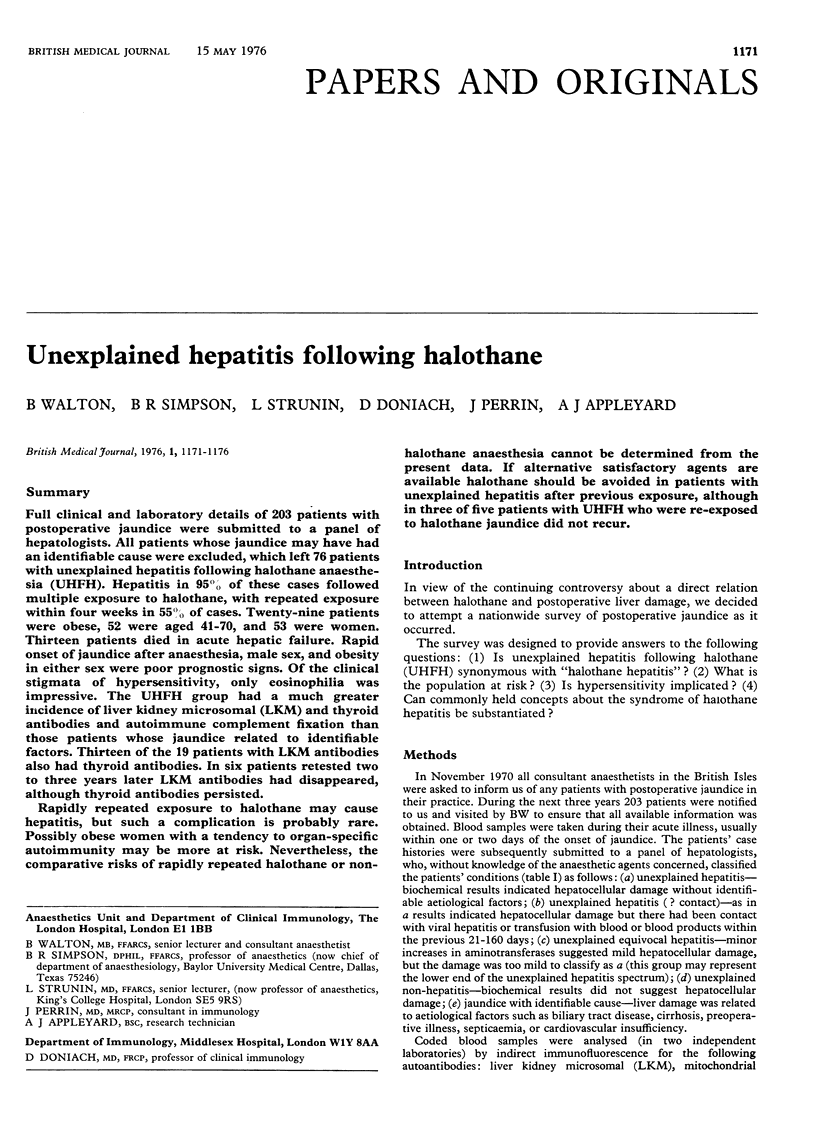
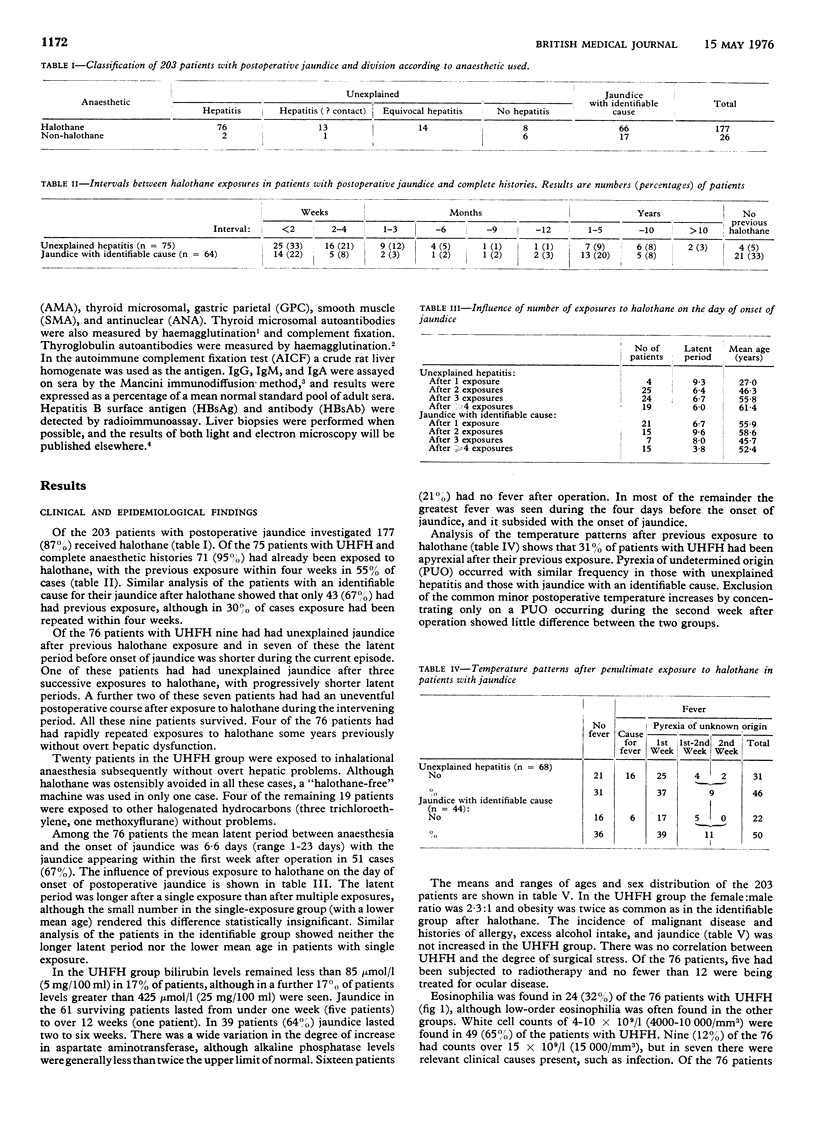
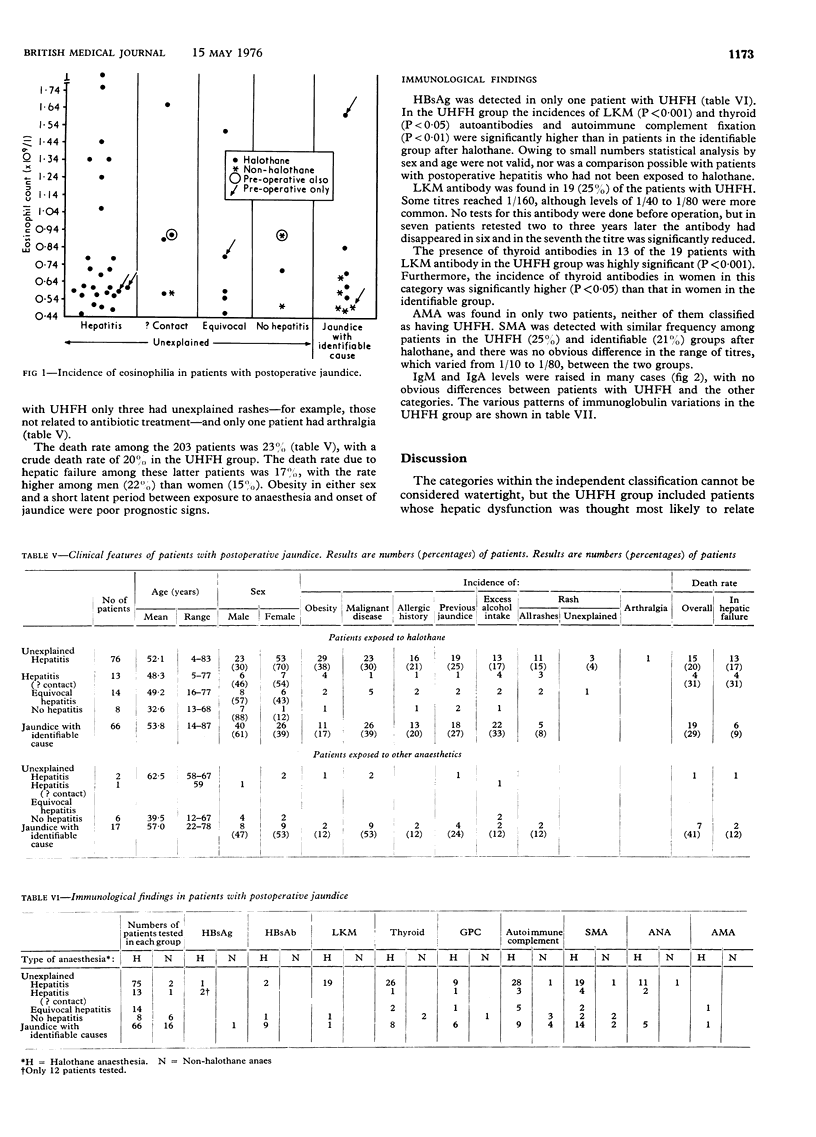
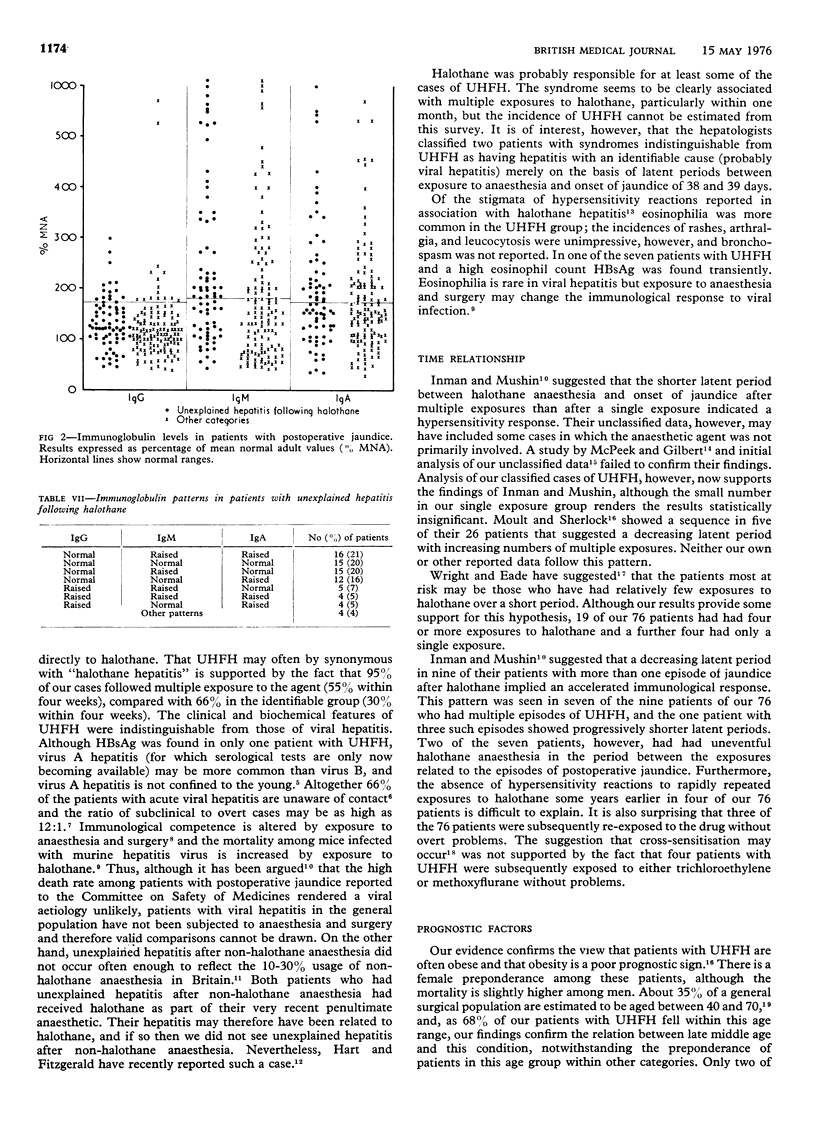
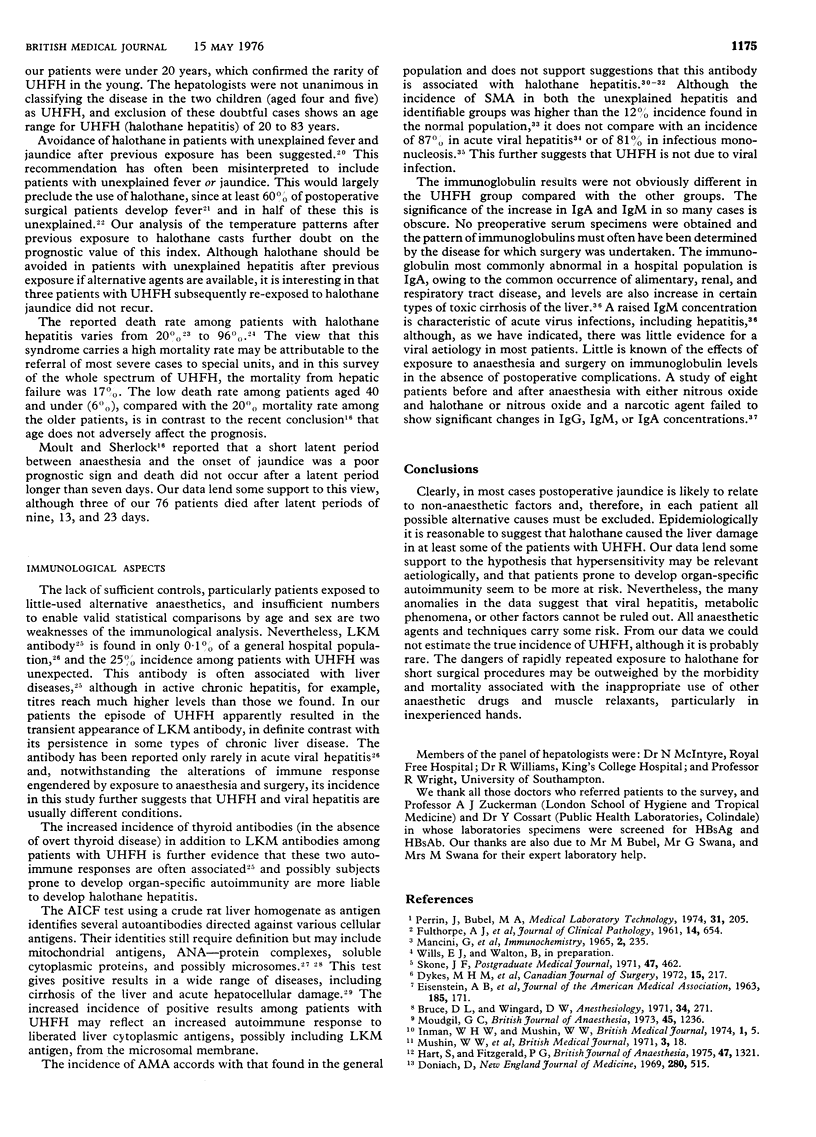
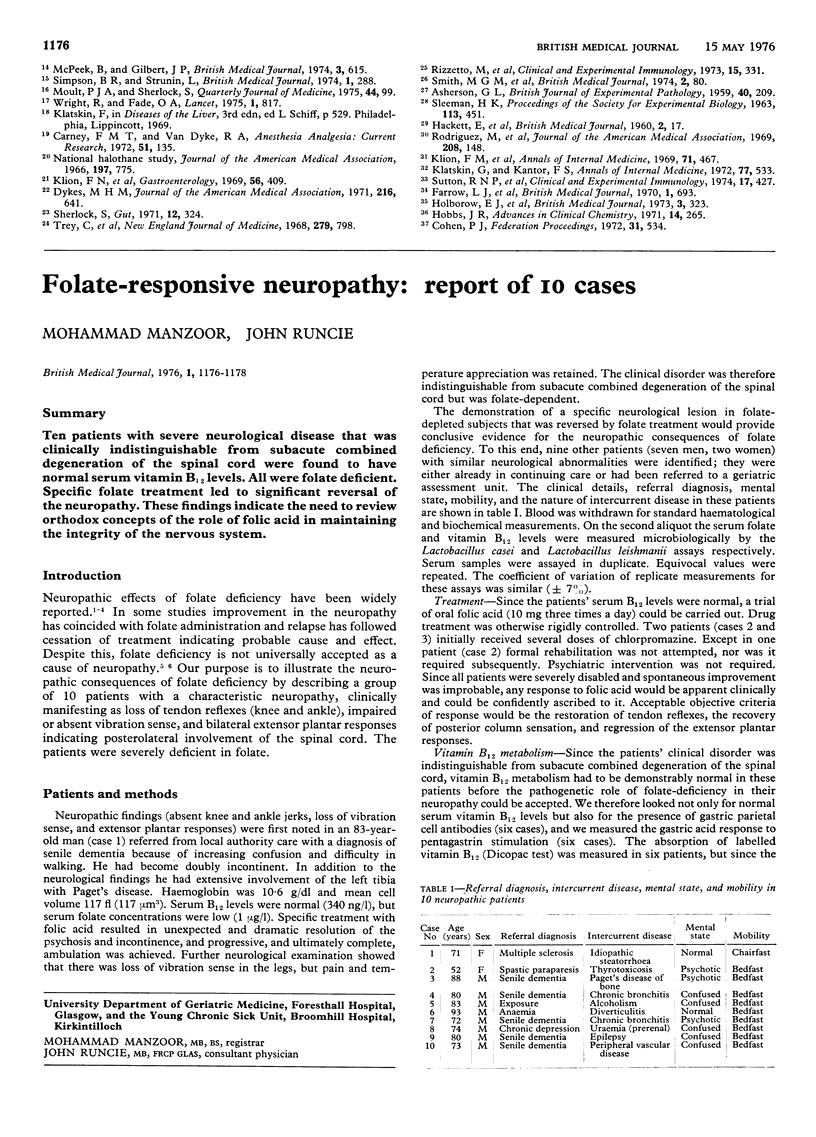
Selected References
These references are in PubMed. This may not be the complete list of references from this article.
- ASHERSON G. L. Antibodies against nuclear and cytoplasmic cell constituents in systemic lupus erythematosus and other diseases. Br J Exp Pathol. 1959 Jun;40(3):209–215. [PMC free article] [PubMed] [Google Scholar]
- Bruce D. L., Wingard D. W. Anesthesia and the immune response. Anesthesiology. 1971 Mar;34(3):271–282. doi: 10.1097/00000542-197103000-00017. [DOI] [PubMed] [Google Scholar]
- Carney F. M., Van Dyke R. A. Halothane hepatitis: a critical review. Anesth Analg. 1972 Jan-Feb;51(1):135–160. [PubMed] [Google Scholar]
- Dykes M. H. Unexplained postoperative fever. Its value as a sign of halothane sensitization. JAMA. 1971 Apr 26;216(4):641–644. doi: 10.1001/jama.216.4.641. [DOI] [PubMed] [Google Scholar]
- FULTHORPE A. J., ROITT I. M., DONIACH D., COUCHMAN K. A stable sheep cell preparation for detecing thyroglobulin auto-antibodies and its clinical applications. J Clin Pathol. 1961 Nov;14:654–660. doi: 10.1136/jcp.14.6.654. [DOI] [PMC free article] [PubMed] [Google Scholar]
- HACKETT E., BEECH M., FORBES I. J. Autoimmune complement-fixation reaction in 1,014 patients. Br Med J. 1960 Jul 2;2(5191):17–20. doi: 10.1136/bmj.2.5191.17. [DOI] [PMC free article] [PubMed] [Google Scholar]
- Hart S. M., Fitzgerald P. G. Unexplained jaundice following non-halothane anaesthesia. A case report. Br J Anaesth. 1975 Dec;47(12):1321–1326. doi: 10.1093/bja/47.12.1321. [DOI] [PubMed] [Google Scholar]
- Holborow E. J., Hemsted E. H., Mead S. V. Smooth muscle autoantibodies in infectious mononucleosis. Br Med J. 1973 Aug 11;3(5875):323–325. doi: 10.1136/bmj.3.5875.323. [DOI] [PMC free article] [PubMed] [Google Scholar]
- Inman W. H., Mushin W. W. Jaundice after repeated exposure to halothane: an analysis of Reports to the Committee on Safety of Medicines. Br Med J. 1974 Jan 5;1(5896):5–10. doi: 10.1136/bmj.1.5896.5. [DOI] [PMC free article] [PubMed] [Google Scholar]
- Klatskin G., Kantor F. S. Mitochondrial antibody in primary biliary cirrhosis and other diseases. Ann Intern Med. 1972 Oct;77(4):533–541. doi: 10.7326/0003-4819-77-4-533. [DOI] [PubMed] [Google Scholar]
- Klion F. M., Schaffner F., Popper H. Hepatitis after exposure to halothane. Ann Intern Med. 1969 Sep;71(3):467–477. doi: 10.7326/0003-4819-71-3-467. [DOI] [PubMed] [Google Scholar]
- Mancini G., Carbonara A. O., Heremans J. F. Immunochemical quantitation of antigens by single radial immunodiffusion. Immunochemistry. 1965 Sep;2(3):235–254. doi: 10.1016/0019-2791(65)90004-2. [DOI] [PubMed] [Google Scholar]
- McPeek B., Gilbert J. P. Onset of postoperative jaundice related to anaesthetic history. Br Med J. 1974 Sep 7;3(5931):615–617. doi: 10.1136/bmj.3.5931.615. [DOI] [PMC free article] [PubMed] [Google Scholar]
- Moudgil G. C. Proceedings: Influence of halothane on mortality from murine hepatitis virus (MHV3). Br J Anaesth. 1973 Dec;45(12):1236–1236. doi: 10.1093/bja/45.12.1236. [DOI] [PubMed] [Google Scholar]
- Perrin J., Bubel M. A. Assessment of a haemagglutination test for thyroid microsomal antibody. Med Lab Technol. 1974 Jul;31(3):205–211. [PubMed] [Google Scholar]
- Rizzetto M., Swana G., Doniach D. Microsomal antibodies in active chronic hepatitis and other disorders. Clin Exp Immunol. 1973 Nov;15(3):331–344. [PMC free article] [PubMed] [Google Scholar]
- Rodriguez M., Paronetto F., Schaffner F., Popper H. Antimitochondrial antibodies in jaundice following drug administration. JAMA. 1969 Apr 7;208(1):148–150. [PubMed] [Google Scholar]
- SLEEMAN H. K. Studies on soluble antigenic substances isolated from human liver. Proc Soc Exp Biol Med. 1963 Jun;113:451–455. doi: 10.3181/00379727-113-28394. [DOI] [PubMed] [Google Scholar]
- Sherlock S. Halothane hepatitis. Gut. 1971 Apr;12(4):324–329. doi: 10.1136/gut.12.4.324. [DOI] [PMC free article] [PubMed] [Google Scholar]
- Skone J. F. Infectious hepatitis in Bristol, 1959-70. Postgrad Med J. 1971 Jul;47(549):462–464. doi: 10.1136/pgmj.47.549.462. [DOI] [PMC free article] [PubMed] [Google Scholar]
- Smith M. G., Williams R., Walker G., Rizzetto M., Doniach D. Hepatic disorders associated with liver-kidney microsomal antibodies. Br Med J. 1974 Apr 13;2(5910):80–84. doi: 10.1136/bmj.2.5910.80. [DOI] [PMC free article] [PubMed] [Google Scholar]
- Sutton R. N., Emond R. T., Thomas D. B., Doniach D. The occurrence of autoantibodies in infectious mononucleosis. Clin Exp Immunol. 1974 Jul;17(3):427–436. [PMC free article] [PubMed] [Google Scholar]
- Trey C., Lipworth L., Chalmers T. C., Davidson C. S., Gottlieb L. S., Popper H., Saunders S. J. Fulminant hepatic failure. Presumable contribution to halothane. N Engl J Med. 1968 Oct 10;279(15):798–801. doi: 10.1056/NEJM196810102791504. [DOI] [PubMed] [Google Scholar]
- Wright R., Eade O. E., Chisholm M., Hawksley M., Lloyd B., Moles T. M., Edwards J. C., GArdner M. J. Controlled prospective study of the effect on liver function of multiple exposures to halothane. Lancet. 1975 Apr 12;1(7911):817–820. doi: 10.1016/s0140-6736(75)93000-7. [DOI] [PubMed] [Google Scholar]


